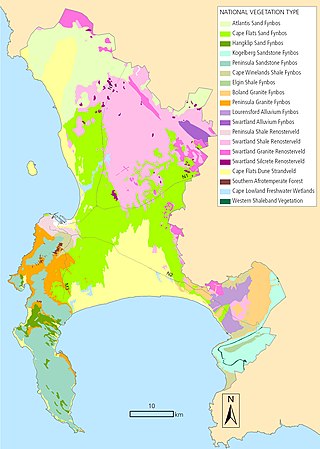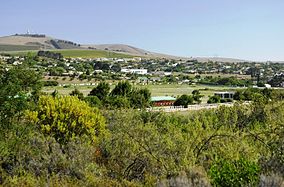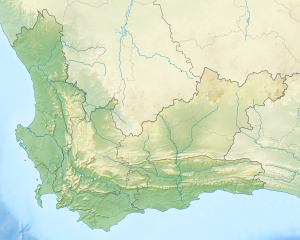
Fynbos is a small belt of natural shrubland or heathland vegetation located in the Western Cape and Eastern Cape provinces of South Africa. This area is predominantly coastal and mountainous, with a Mediterranean climate and rainy winters. The fynbos ecoregion is within the Mediterranean forests, woodlands, and scrub biome. In fields related to biogeography, fynbos is known for its exceptional degree of biodiversity and endemism, consisting of about 80% species of the Cape floral kingdom, where nearly 6,000 of them are endemic. This land continues to face severe human-caused threats, but due to the many economic uses of the fynbos, conservation efforts are being made to help restore it.

The Cape Floral Region is a floristic region located near the southern tip of South Africa. It is the only floristic region of the Cape Floristic Kingdom, and includes only one floristic province, known as the Cape Floristic Province.

The wildlife of South Africa consists of the flora and fauna of this country in southern Africa. The country has a range of different habitat types and an ecologically rich and diverse wildlife, vascular plants being particularly abundant, many of them endemic to the country. There are few forested areas, much savanna grassland, semi-arid Karoo vegetation and the fynbos of the Cape Floristic Region. Famed for its national parks and big game, 297 species of mammal have been recorded in South Africa, as well as 849 species of bird and over 20,000 species of vascular plants.

The geometric tortoise is a critically endangered species of tortoise and one of three members of the genus Psammobates. It is found in a very small section in the South-Western Cape of South Africa.

Renosterveld is a term used for one of the major plant communities and vegetation types of the Cape Floristic Region which is located in southwestern and southeastern South Africa, in southernmost Africa. It is an ecoregion of the Mediterranean forests, woodlands, and scrub biome.

The Biodiversity of Cape Town is the variety and variability of life within the geographical extent of the City of Cape Town metropolitan municipality, excluding the Prince Edward Islands. The terrestrial vegetation is particularly diverse and much of it is endemic to the city and its vicinity. Terrestrial and freshwater animal life is heavily impacted by urban development and habitat degradation. Marine life of the waters immediately adjacent to the city along the Cape Peninsula and in False Bay is also diverse, and while also impacted by human activity, the habitats are relatively intact.

Cape Flats Sand Fynbos (CFSF), previously known as Sand Plain Fynbos, is a critically endangered vegetation type that occurs only within the city of Cape Town. Less than 1% of this unique lowland fynbos vegetation is conserved.

Lourensford Alluvium Fynbos is a critically endangered vegetation type that is endemic to Cape Town. Though closest to Fynbos, it has characteristics of both Fynbos and Renosterveld vegetation and is thus actually a unique hybrid vegetation type.

Peninsula Shale Renosterveld (PSR) is a unique vegetation type that is found only on the slopes of Signal Hill and Devil's Peak in Cape Town, South Africa. It is critically endangered and exists nowhere else.

Swartland Shale Renosterveld is a critically endangered vegetation type of the Western Cape, South Africa.

Cape Winelands Shale Fynbos is a vegetation type that naturally occurs in the Cape Winelands of the Western Cape, South Africa.
Glencairn Wetland is a small 20-hectare (49-acre) reserve on the Cape Peninsula, in the southern areas of Greater Cape Town, South Africa.

Tygerberg Nature Reserve is a 300-hectare (740-acre) nature reserve on the Tygerberg Hills in the northern suburbs of Cape Town, South Africa.

Uitkamp Wetland Nature Reserve is a 32-hectare (79-acre) wetland reserve located in Durbanville in the Western Cape province of South Africa.

Bracken Nature Reserve is a 36-hectare (89-acre) piece of protected land in Brackenfell in the Western Cape, South Africa.

Harmony Flats Nature Reserve is a 9-hectare (22-acre) piece of protected land, located between Strand and Gordon's Bay, South Africa. It protects a surviving fragment of critically endangered Lourensford Alluvium Fynbos vegetation.

Helderberg Nature Reserve is a 398-hectare (980-acre) nature reserve in Somerset West, South Africa.
Blaauwberg Nature Reserve was proclaimed a local and provincial nature reserve in 2007. The reserve has views down fynbos slopes, across the city, to seven kilometres of rocky and sandy coastline and the ocean and beyond. The reserve presents itself as one of the few viewpoints in the world from where you can see two proclaimed world heritage sites, namely Table Mountain and Robben Island.

Silwerboomkloof Natural Heritage Site is a small, protected valley (“kloof”), near the Helderberg Nature Reserve, in Somerset West, South Africa.



















